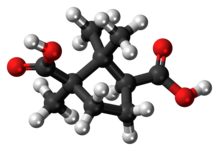This article includes a list of references, related reading, or external links, but its sources remain unclear because it lacks inline citations .(January 2012) |
 | |
 | |
| Names | |
|---|---|
| IUPAC name (1R,3S)-1,2,2-trimethylcyclopentane-1,3-dicarboxylic acid | |
| Identifiers | |
3D model (JSmol) | |
| ChEMBL | |
| ChemSpider | |
| ECHA InfoCard | 100.241.243 |
| EC Number |
|
PubChem CID | |
| UNII |
|
CompTox Dashboard (EPA) | |
| |
| |
| Properties | |
| C10H16O4 | |
| Molar mass | 200.234 g·mol−1 |
| Density | 1.21 g/cm3 |
| Melting point | 183 to 187 °C (361 to 369 °F; 456 to 460 K) |
| −129.0·10−6 cm3/mol | |
Except where otherwise noted, data are given for materials in their standard state (at 25 °C [77 °F], 100 kPa). | |
Camphoric acid, C 10 H 16 O 4[ citation needed ] or in Latin form Acidum camphoricum, is a white crystallisable substance obtained from the oxidation of camphor. It exists in three optically different forms; the dextrorotatory one is obtained by the oxidation of dextrorotatory camphor and is used in pharmaceuticals.